Harry Blackstone Sr (Harry Blackstone)

Harry Blackstone Sr
Blackstone was in the mode of courtly, elegant predecessor magicians like Howard Thurston and Harry Kellar, and the last of that breed in America. He customarily wore white tie and tails when performing, and he traveled with large illusions and a sizable cast of uniformed male and female assistants. For a number of years he toured in the Midwest, often performing throughout the day between film showings. Blackstone remained silent during much of his big stage show, which was presented to the accompaniment of a pit orchestra and such lively tunes of the time as “Who”, “I Know That You Know”, and “Chinatown.” Among his especially effective illusions was one in which a woman lying on a couch and covered with a gossamer shroud appeared to float high in the air and then vanish, as Blackstone pulled off the covering. In another illusion, a woman stepped into a cabinet in front of many bright, clear, tubular incandescent light bulbs. When the magician suddenly pushed the perforated front of the cabinet backward the light bulbs protruded through the holes in the front of the box (to the accompaniment of the lady’s blood-curdling scream). The cabinet was then revolved so that the audience seemed to see the lady impaled by the blinding filaments.
His “Sawing a woman in half” involved an electric circular saw some three to four feet in diameter mounted on a swing-down arm. Blackstone demonstrated the efficacy of the device by sawing noisily through a piece of lumber. Then a female assistant was placed on the saw table in full view, as wide metal restraints were clamped upon her midsection. The blade whirred and appeared to pass through her body, as ripping sounds were heard, the woman shrieked, and particles were scattered by the whirring blade. When the blade stopped she, of course, rose unharmed. In a gentler turn was his “Vanishing bird cage,” an effect in which a score or more of children were invited to join him on the stage and all “put their hands on” a tiny cage holding a canary. Blackstone lowered the cage and then seemed to toss it into the air: bird and cage “disappearing” in the process to the astonishment and delight of the surprised children.
Among his lovelier effects was “The Garden of Flowers,” in which countless bouquets of brilliant feather flowers appeared from under a foulard and on tables and stands until the stage was a riot of color. “The Floating Light Bulb,” was perhaps his signature piece. In a darkened theatre, Blackstone would take a lighted bulb from a lamp and float it, still glowing, through a small hoop. He would then come down from the stage and the lamp would float out over the heads of the audience. Dutch illusionist Hans Klok became the custodian of Blackstone, Sr.’s famous “floating light bulb” illusion after the death of Blackstone, Jr. When not on tour, Blackstone lived in Colon, Michigan, where he had an interest in Abbott’s Magic Novelty Company. The enterprise shipped simple, inexpensive tricks (with mimeographed instructions) to young boys all over America, while also building large illusions for stage magicians.
Blackstone spent the last years of his life performing at The Magic Castle, a magical attraction in Hollywood, California. He died in November 1965 at the age of 80. He was interred close to his former home in Colon, Michigan where the main street was renamed Blackstone Avenue in his honor. Books carrying Harry Blackstone’s byline were ghostwritten for him by his friend, Walter B. Gibson, who also created, in 1941, the comic book Blackstone the Magician Detective and the 1948-49 radio series, Blackstone, the Magic Detective. In 1985, on the 100th anniversary of his father’s birth, Harry Blackstone, Jr. donated to the Smithsonian Institution in Washington D.C. the original floating light bulb – Thomas Edison designed and built it – and the original Casadega Cabinet, used in the “Dancing Handkerchief” illusion. This was the first ever donation accepted by the Smithsonian in the field of magic.
Born
- September, 27, 1885
- Chicago, Illinois
Died
- November, 16, 1965
- Los Angeles, California
Cause of Death
- pancreatic cancer
Cemetery
- Lakeside Cemetery
- St. Joseph County Michigan



